By Gijsbert-Paul Berk
Since the mid-thirties, when he had developed the body of the Dynamic, Bionier had been interested in aerodynamics. He loved to watch birds in the air and fish in aquaria. Their movements and shapes fascinated him. During the war years he had studied and even made some scale models to determine how the postwar Panhards should look.

During the dark years of WWII Bionier made several studies for an aerodynamic postwar Panhard. This 1/5 scale model was one of them.
Like most designers at that time he had learned that the drag or air resistance of a car was determined by its frontal area, a wind cheating shape at the front and a rear end that held the airstream and limited turbulence. In short, the body of a car should resemble as closely as possible the contours of a raindrop. With this in mind he made wooden 1:5 scale models and had them tested in the wind tunnel of the Institute Aérodynamique in Saint-Cyr.

Louis Bionier with a wind tunnel model for the Dynavia concept car that was realized on a Dyna X chassis.
Two prototypes were built and road tests showed that with the same 28 bhp, 610 cc engine, it could reach130 km/h (80 mph), 18 % more than the Dyna production model. One of the prototypes was exhibited at the 1948 Paris Motor Show, where its futuristic shape created a lot of positive comments from the media and the public. This convinced Paul and Jean Panhard, who gave Bionier ‘carte blanche’ to design an aerodynamic body for the next generation of Dyna’s.
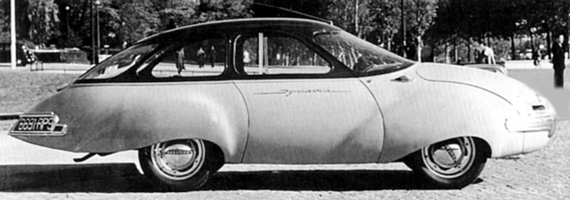
Side view of the Panhard Dynavia. As this concept car was built on a chassis of a Dyna X, its short wheelbase somehow spoiled the balance of the design. The Dynavia was a relatively small car. The shape with its extreme long and tapered tail and large glass house was light-years ahead of the then current designs.
A new challenge; design a new Dyna.
In less than 30 months, Bionier assisted by André Jouan and a small army of engineers and technicians from Panhard, the Compagnie Aluminium Française (which would press the light alloy body panels) and Saint Gobain (supplier of the panoramic windscreen and rear window) designed, tested and prepared the production of a totally new car. Panhard did not wait till the Paris Motor Show in October but unveiled the new Dyna Z, also called Dyna 54, on 17 June 1953 in the luxurious restaurant Les Ambassadeurs at the Hôtel Crillon on the Place de la Concorde in Paris.
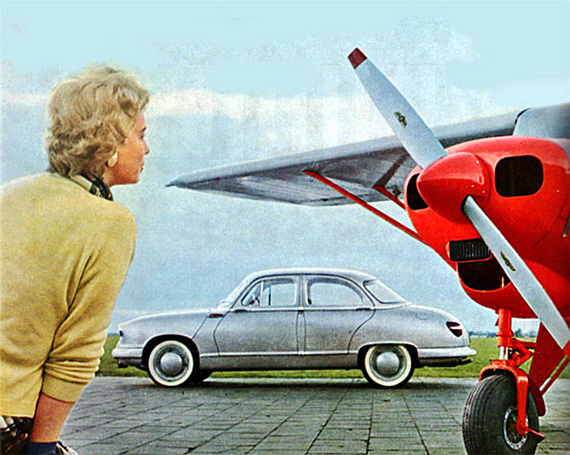
If you are not seduced by its modern style, these facts will convince you: air cooled engine, efficient aerodynamic body of lightweight aluminum construction. Curb weight 710 kg (1,570 lb), top speed 130 km/h (80.78 mph) and fuel consumption only 15 liters/100 km (15.68 US MPG). (Text from a 1954 Panhard advertisement for the Dyna Z.)
It was, if not a revolutionary, then certainly an unconventional automobile with a relatively large body, but still powered by the rather small air-cooled cylinder engine. Its very clean ‘pontoon’ type (integrated fenders in the USA) coachwork had a monocoque frame structure, made from Duralinox (an aluminum alloy containing copper and magnesium). A steel sub-frame located at the front, contained the engine with the transmission and front suspension. The rear axle with its transverse torsion bar suspension units and the shock absorbers were mounted on another steel sub-frame at the back. The new Dyna Z had a wheelbase of 2570 mm (101 in), 21% longer than that of the preceding Dyna X. From nose to stern it measured 4570 m (180 in), which was 25% more. It was 1668 mm (65.7 in) wide (+ 16 %). The roomy Dyna Z, which in France could officially carry 6 people, had a dry weight of only 710 kg (1600 lb.), about 15% more than the latest and most powerful Dyna X.
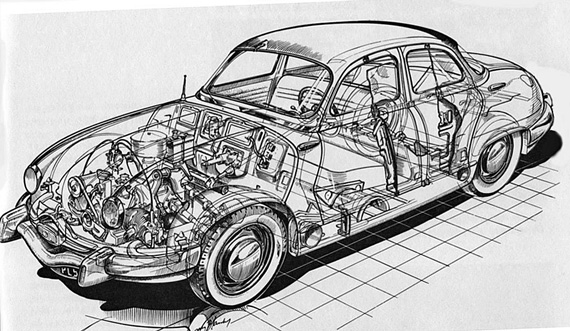
A cut-away or ghost drawing of the Panhard Dyna Z, from the book “Panhard, Toute l’histoire” by Benoît Pérot (Editions E/P/A 1994).
For the sporting Panhard Junior* two-seater Delagarde had already enlarged the cubic capacity of the air-cooled twin engine to 851 cc. A slightly tuned down version developing 42 bhp @ 5000 rpm, was used in the Dyna Z. Thanks to the efficient and aerodynamic shaped body, with a CX of 0.26, the new car reached a top speed of 130 km/h. Up to the introduction in 1959 of its successor the Panhard PL17, some 141,348 Dyna Zs were produced.
The Citroen Merger
In 1951- 1952, while Bionier and his team were developing the new Dyna Z, Paul and Jean Panhard contacted Ford France to discuss the possibilities of integrating of their engineering and production facilities. On paper this looked quite sensible, but the plan eventually fell through.
In the meantime the condition of Panhard’s resources had further deteriorated. The company urgently needed more capital to finance the investment for the production of the new Dyna model. But their bank, Crédit Lyonais, was only willing to help if the original shareholders, the Panhard family and some close friends, would also increase their financial participation. According to Jean Panhard, some of those shareholders could not or did not wish to participate in a subscription to increase the capital.
The outcome was that in April 1955, the boards of the SAAE Panhard et Levassor and SA Citroën (then still owned by the Michelin family) agreed to a far reaching cooperation. Citroën, which needed to free up factory space for the production of their new DS, was to transfer the assembly lines of their 2CV vans to the plant of Panhard et Levassor at the Avenue d’Ivry. Panhard had to build and finish up to 500 of these Citroëns per day as a subcontractor. Citroën would provide all the technical assistance and machine tools Panhard needed and furthermore participate financially to increase the capital of Panhard. As a result of which Citroën was to get a share of 25 % in the SAAE Panhard et Levassor.
The Dyna Z would also be sold by the more extensive Citroën dealer network. This gave Panhard more sales opportunities especially in export markets.
At the time, the agreement between Panhard and Citroën seemed a real win-win solution, with benefits for both parties.
What made Panhard decide to switch over to steel bodies?
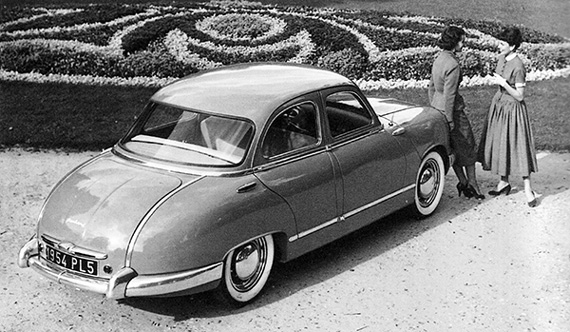
The Dyna in ’54. Une grande Voiture! Indeed the new Panhard Dyna Z was much larger than the previous Dyna model.
It is certain that Bionier was fully aware what was going on and one could believe he would have been relieved that the production of his new Panhard Dyna Z would not be affected by money problems, but he was wrong. The financial department at Panhard soon calculated that the cost of producing the lightweight body parts was going up because of the price increase of aluminum. So in 1957 the body structure was changed from Duralinox to steel and in due course the doors, hood and trunk followed. There was another reason for this switch as well. Insurance companies discovered that the Dyna aluminum body was more vulnerable and repairs were more expensive than with comparable models from other makes with steel bodies. Of course they adjusted their conditions accordingly. At that time Panhard’s commercial sales staff were trying to sell cars to G7, one of the leading taxi operators in Paris. They were enthusiastic about the space and fuel economy the Dyna offered but were hesitating because of the high insurance premiums.
The PL 17 was more than a Dyna in evening dress.
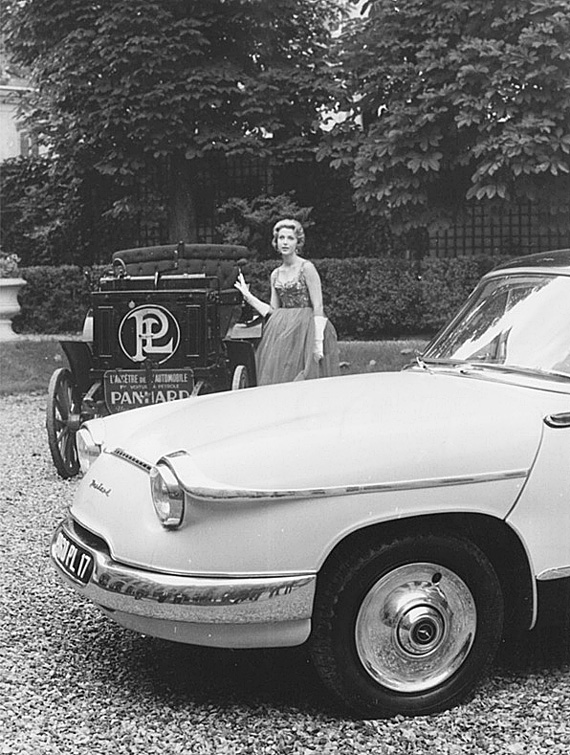
In 1959 Panhard introduced the successor to the Dyna Z and replaced the name Dyna with PL17. This was in reference to the French automobile pioneers and founders of the company Panhard et Levassor.
The switch over to a steel body structure and a number of improvements and refinements of the engine that was now equipped with hydraulic valve lifters to reduce tappet noise, greatly added to the quality of the car. The reputation of the Dyna Z had been seriously dented by the earlier teething troubles and mechanical problems, therefore the Panhard management wanted to upgrade its image. So on 29 June 1959, the Panhard Dyna Z was replaced by the Panhard PL 17. The name Dyna was dropped. The letters PL stood of course for Panhard et Levassor. The PR people of Citroen/Panhard explained the number 17 by suggesting a magical formula; the sum of 5 (for 5 CV, the French horsepower rating) + 6 (for six seats) + 6 (for the fuel consumption of 6 liter/100 km (39 miles per US gallon). Clever, but I personally think that the figure 17 was thought up by some marketing wizards to indicate the position of this new Panhard model under that of the Citroën DS 21.
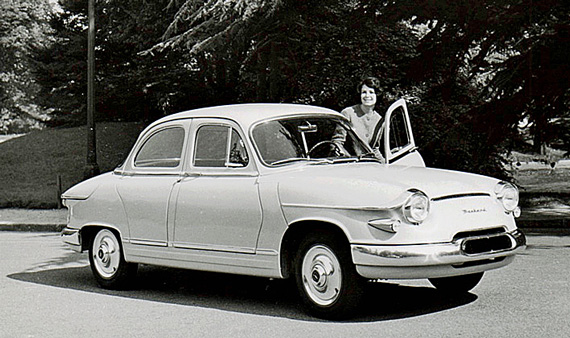
With its changed name the new Panhard PL17also lost its suicide doors. They now swung out at the rear.
At first sight the PL 17 looked like a Dyna Z in evening dress with some custom jewelry added in the way of chromium-plated embellishments on the hood and fenders, in fact Bionier had completely redesigned both the front and the rear and more importantly, replaced the ‘suicide’ (rear-hinged) front doors. The new dashboard was also more in style with the sporting character of the car. Ordering the ‘Relmax’ version (Relax Maximum), clients obtained two separate chairs with adjustable reclining backrest instead of the single bench front seat. There was also a choice between the standard 40 bhp engine or the 50 bhp ‘Tigre’.
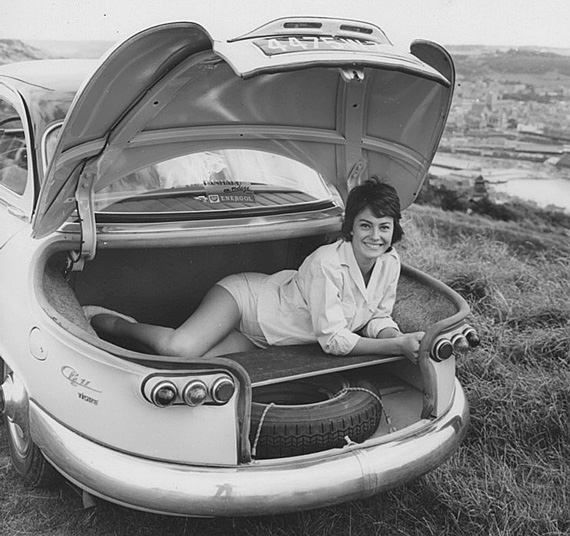
Can you think of a more French and charming way to illustrate the capacity of a luggage compartment? It also hides the fact that its height was rather limited because of the horizontal mounted spare wheel on the floor.
The very attractive two door, four seat cabriolet (convertible) introduced in the Dyna Z range remained available. This special body was not designed by Bionier but by the Belgium coachbuilder Albert D’Ieteren from Etterbeek. Using the platform of a Dyna Z he had exhibited it on his stand at the 1956 Brussels Motor Show. Panhard subsequently acquired the manufacturing rights and produced a limited number of these bodies in their workshop at Orleans but in the spring of 1963 the production of the cabriolet was stopped to make way for the PL 17 break (station wagon). All together Panhard produced some 130,000 PL 17’s.
Note: The Panhard Junior is not further described here, as it was not designed by Bionier. The car was an idea of J.B. Fergusson of Fergusson Motors in New York. He wanted a small sporting roadster to sell to young Americans and contacted Panhard to supply the chassis and engines of the Dyna. He also approached the Société Industrielle Aéronautique et Automobile (SIA) in Garenne-Collombes, a coachbuilding company that was run by the Di Rosa family. The initial design for the Panhard Junior was made by Albert Lemaire, one of their draftsmen. When Fergusson abandoned the project Paul Panhard decided to take it over. But that is another story.

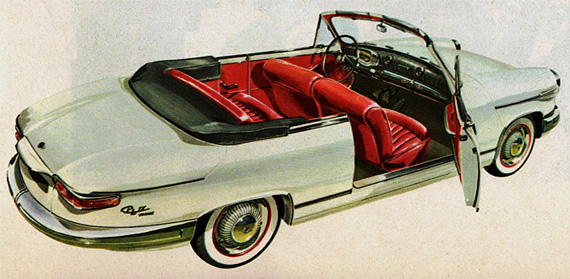
In my long ago travels I was contacted by a friend who told me about Panhards. It seemed that a Long Island Lincoln/ Mercury dealer (S & R Lincoln/Mercury, Rockville Centre) was negotiating the distribution rights for Panhard. I was interested in getting involved. Somewhere along the way My friend Paul and I managed to purchase a package of two Panhards from Paul Sagan, a VW/Porsche dealer in Uniondale. One was a complete Panhard Junior sport, and the other was a rolling chassis for a similar car, with a parts kit to complete the assembly, minus the body (which was steel and not particularly good looking). In my efforts to sell off the chassis, I placed an advert in the Sunday “Times”, and much to my surprise I got an almost immediate call from a Mr. Merwin Tober from Springfield, Mass, who arrived forthwith, with a tow-truck, paid the money and took the car away.
The engineering of the Panhard was interesting, with its torsion bar valve springs and high revving roller bearing crank. Don Falk
Bravo encore une fois Mssr Gijsbert-Paul Berk and thanks so much for your diligent and interesting background research information. – being recounted in English is a huge bonus, for those of us linguistically impaired, Greg
great article, have to point out though, that there is a small fault under the Picture of the PL17, the PL17 retained its suicide doors for the first production year and into 1960, where they at some point got hinged the “normal” way. I own the remains of a early PL17 so I got hard evidence to prove it.
Mes Amies du Panhard…. I have been emotionally and physically attached to Panhard since my early days (1954) with Panhards..while living (Military Service) in France…from the days of hitch hiking into Paris…and being picked by a gentleman whose Dyna Panhard kept sticking in second/third gear…but not to worry, he would race the disengage the clutch and “coast” awhile….I have had seven Deutsch Bonnett’s with of course Panhard engines…and now have a 24bt….one of two that I have had respectively…I know and have had dinner with Ann DeLagarde, the daughter of the French engineer who designed and built the Panhard engine….a nice lady who drives a Panhard 24Bt! Also while in the military, I was introducted to he 12 cylinder (yes 12), Panhard married together as the source of power for their 75mm Wheeled Artillary Weapon, and also an Armed Car…Fantastic equipment….The design of the Panhard PLly reminds me of “racing” with a GI in a l950 Chevrolet against a Panhard…..poor,poor Chevrolet….driver was scared to death in his attempt to distance himself from the Two Cylinder “voiture”…Further it is said in France…if you are “at” speed in you DS21 and you hear a horn blowing wanted the road….it is a two cylinder Panhard wanted to pass…Vive La Panhard